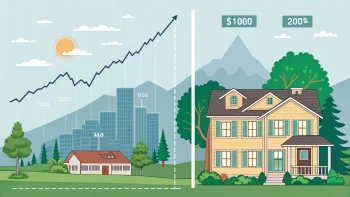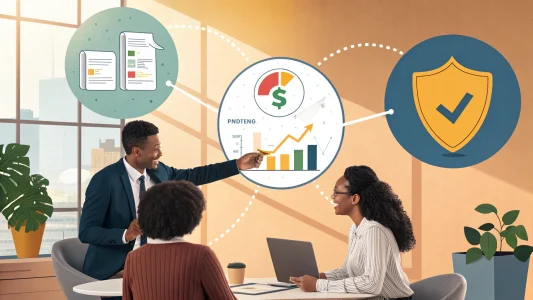With 2025 winding down, will savers and investors lock in today’s CD or Treasury yields before they slip lower, or hold out for better returns in 2026? It’s not an easy choice with the Fed signaling cuts, inflation a wild card, and the markets sending mixed signals.
Let me break down the risks, opportunities, and strategies so you can decide whether now is the right time to lock in your rate–or not.
Table of Contents
ToggleThe Current Interest Rate Environment: What’s Happening Now
If you want to evaluate whether you should lock in rates now, you need a context to help you.
- The Federal Reserve lowered the federal funds rate to 4.00%–4.25% in September 2025. There’s also an indication that two additional cuts are possible later in the year.
- The yields on CDs and savings accounts have already started to drift downward in many cases. There is a creeping trend towards 4% on the highest-yielding 1-year CDs, which had been in the mid-4% range.
- In line with the Fed’s lead, analysts expect CD rates to fall further during late 2025.
- On the Treasury side, yields on the 10-year U.S. Treasury will remain near 4.0% through the end of the year, with a modest decline in the second half.
- By 2027, Deloitte projects yields to ease to around 4.1% — a gradual decline in long-term rates.
- While fiscal pressures and investor concerns over U.S. deficits may support longer-dated Treasuries’ yields, longer-dated term premiums could rise.
In short? We may have already passed the peak in interest rates. Due to risk premiums and issuance dynamics, CDs and short-term Treasury yields are expected to drift downward through 2025 and 2026.
CD vs Treasury: Key Differences and Trade-Offs
CDs and Treasury bills differ in several important ways, so it’s important to understand them before locking in anything.
| Feature | Certificate of Deposit (CD) | U.S. Treasury Securities |
|---|---|---|
| Issuer | Banks, credit unions (insured by FDIC up to $250K) | U.S. government (backed by full faith & credit) |
| Liquidity / early access | Usually, there is a penalty if you withdraw before maturity | Treasuries can often be sold earlier in the secondary market, though price risk applies |
| Interest structure | Fixed rate for term | Fixed coupon; market yields fluctuate |
| Maturity options | Terms from months to years | T-bills (short), notes (2–10 yrs), bonds (10+ yrs), TIPS |
| Tax treatment | Interest taxed as ordinary income (federal + possibly state/local) | Interest taxed federally; exempt from state/local income taxes |
There are advantages to both. A CD offers safety and simplicity. Treasuries offer flexibility and a deeper market. Timing, horizon, and yield expectations all play a role in the decision.
When Locking in Makes Sense: The Advantages of Going Now
There are several scenarios where locking in now (late 2025) with a CD or Treasury may be a wise move;
- Expectations of rate declines. By locking in yields now, you protect yourself against dropping rates in 2025 and 2026 if you trust the Fed to continue reducing rates. For instance, many analysts anticipate CD yields slipping as rates follow.
- Safety and certainty. If preserving capital and locking in a known yield is more important than chasing upside, now is a good time to take a conservative approach.
- Laddering strategy. It’s not necessary to lock everything at once. Depending on your goals, you might stagger maturities across 6, 12, and 24 months.
- To match known future liabilities. If you know that you will need money in a particular year, it’s a good idea to lock it in to a low-risk investment vehicle.
- Limited alternatives. High-grade fixed-income may offer relative appeal if equities or corporate credit appear overvalued.
Even so, locking in isn’t always the best idea. The better alternative is to wait.
When Waiting May Offer Better Returns
There are a few reasons why you might want to delay;
- Possibility of higher rates ahead. Depending on whether inflation surprises or fiscal stress pushes longer-term yields upward, future rates may exceed those you can lock today.
- Opportunity cost. The longer you lock in, the less likely it is that you can take advantage of higher yields in shorter instruments that reprice.
- Flexibility and reinvestment optionality. By holding cash or short maturities, you have the option to move into a better rate or opportunity in the future.
- If you anticipate rate cuts already priced in. The market may already have discounted rate cuts, so the upside potential is limited.
With most forecasts pointing to falling rates by 2025, half-locking now while leaving some duration uncommitted may offer a balanced approach.
Tactical Playbook: How to Decide
Using the following framework, you can act strategically.
Define a time horizon.
- Short horizon (1–2 years). Invest in CDs or short-term Treasuries (1–3 years) so you aren’t stuck for too long if interest rates change.
- Intermediate (3–5 years). If you tolerate more maturity, be selective; the long-term rate may decline.
- Long-term (10+ years). You may want to consider locking maturities, but accept inflation and duration risks.
Estimate the expected rate path.
- Locking now makes sense if you believe yields will fall.
- You should delay all-in commitments if you believe they will tick up or stay flat.
Ladder or tranche your investments.
Don’t put everything in one bucket. As an example;
- 25% in 6 months
- 50% into 1–2 years
- 25% in 3+ year bonds or notes
As a result, you get both yield and flexibility.
Match risk to credit/tax needs.
- A CD or government Treasury is a low-risk investment if safety is paramount.
- To hedge your portfolio, consider Treasury Inflation-Protected Securities (TIPS) or Series I bonds.
Monitor the market.
Keep an eye on Fed signals, inflation prints, Treasury auctions, and macro surprises. Whenever the market moves strongly in one direction, adjust your allocations accordingly.
Sample Scenarios and Implications
To help you make a wise financial decision, here are a few real-world examples.
Scenario A: Fed cuts more than expected.
In the event of aggressive Fed cuts, short-term yields will fall faster than long-term yields, and the yield curve will steepen. If so, then;
- A CD with a long lock-in period or a 5-year Treasury bond may perform better than a CD with rolling short rates.
- Using a laddered structure gives you winners in the long run, while letting other portions reprice.
Scenario B: Inflation or fiscal shock.
Even if the Fed cuts interest rates, long-term rates could rise if inflation turns up or deficit concerns spike. Assuming that scenario;
- The performance of your fixed-rate CD or long Treasury may lag that of newer issuances.
- Instruments with shorter maturity retain flexibility in repositioning.
Scenario C: Flat or slow descent.
Locking in moderate maturities now and being patient with rollover gains is the most advantageous trade-off if the yield curve drifts lower.
These scenarios highlight why flexibility, guarded conviction, and staggered exposure often outperform going “all in.”
Risks and Caveats to Watch
Don’t assume that all “safe” investments are risk-free before investing your money. The returns, flexibility, and even the tax bills of CDs and Treasuries are all subject to trade-offs. As such, you should keep the following pitfalls in mind.
- Interest rate risk. Whenever rates move, bond prices react — sometimes sharply. When yields rise after you lock in, longer-term Treasuries are especially vulnerable.
- Inflation erosion. When inflation eats away at your purchasing power, even a healthy nominal yield can lose its appeal.
- Liquidity constraints. In many cases, these products tie up your money, and getting out early can be costly.
- Credit and reinvestment risk. While Treasuries are as close to “risk-free” as they get, reinvestment risk still matters when cash flows return in a low-rate environment.
- Tax treatment. Interest is taxed differently depending on the type. You may be able to affect your after-tax return if you understand the difference between CDs and Treasury bonds.
Why You Might Want to Lock in a Rate Now
On the other hand, today’s market environment still offers compelling reasons to lock in yields before they decline. Right now, CDs and Treasuries can play an important role in your portfolio if you prioritize stability and guaranteed returns.
- Secure high rates before they fall. Likely, CDs and Treasuries will no longer offer high yields as the Fed cuts rates. If you lock in a high fixed rate now, you can guarantee solid returns for six months or several years.
- Insulate yourself from market volatility. Stock market volatility can be mitigated by investing in CDs and Treasuries, which are considered safe, low-risk investments. Unlike high-yield savings accounts with variable rates, fixed-rate CD yields are guaranteed and unaffected by changes in interest rates.
- Take advantage of the current inverted yield curve. When the yield curve inverts, short-term rates are higher than long-term rates. As a result, investors can earn excellent returns on shorter-term products, such as one-year CDs, before rates fall further.
Strategies for Acting Now
If you’re considering locking in, the question becomes how. With a shifting rate environment, there are different approaches to balancing return, flexibility, and cash access.
- CD laddering. If you want to access cash while locking in high rates, consider building a CD ladder. An investor invests a lump sum in multiple CDs with staggered maturities (e.g., 6-month, 1-year, and 2-year terms). In this way, a portion of your funds becomes available at regular intervals.
- Consider a no-penalty CD. Banks and credit unions sometimes offer no-penalty CDs. With no-penalty CDs, you can withdraw funds early without paying a fee, while bump-up CDs let you raise your interest rate if rates rise. Although their initial rates may be lower, these products may offer more flexibility.
- Compare short-term vs. long-term. Given the current inverted yield curve, short-term CDs (under 1 year) remain very competitive. Short-term CDs can be a good option if you need access to your funds soon. Even though the initial rate may be slightly lower, a longer-term CD will shield you from future rate cuts if you want a guaranteed return over a longer period.
Final Take: Act with Intention, Not Emotion
If you want to lock in a CD or Treasury before 2026, don’t choose the perfect rate—instead, position for what seems most likely while respecting uncertainty. As the year progresses, many signs point to a rate decline in late 2025 and slower returns going forward. Therefore, it might be a good idea to lock in capital now.
Flexibility, however, is your friend. When unexpected events occur, you’re prepared by maintaining liquidity and laddering maturities.
Before you decide to move forward, consider these things;
- Identify your income needs and horizon.
- Think about how the rate path will look.
- Invest your capital across a range of maturities.
- Markets can surprise you, so be prepared to adjust.
By locking in reasonable rates today (e.g., CDs or Treasuries earning 4%+), you ensure a part of your portfolio is compounding safely while still leaving room for upside.
Image Credit: Nataliya Vaitkevich; Pexels

















